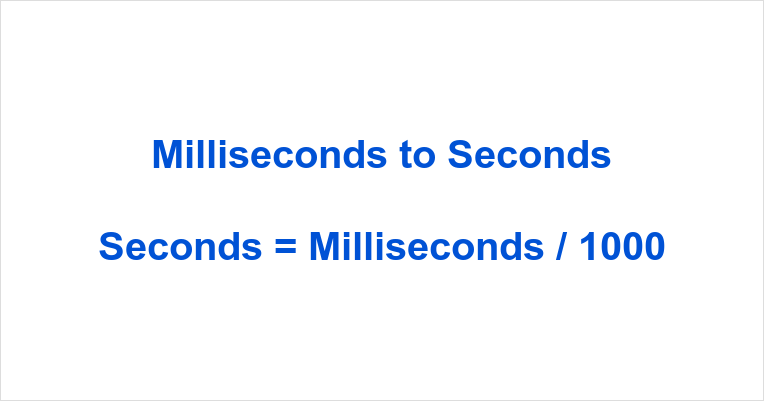Understanding Time: How Many Milliseconds Are in a Second?
Time is a fundamental concept that governs our daily lives, activities, and interactions. In various fields, precise measurements of time are crucial, especially in science, technology, and everyday applications. One common question that arises is: How many milliseconds are in a second? This article will explore this question in detail, explain the significance of milliseconds, and provide context for their use in various fields. Additionally, we will include a FAQ section and a summary table for quick reference.
1. The Basics of Time Measurement
1.1 Definition of a Second
A second is the base unit of time in the International System of Units (SI). It is defined based on the vibrations of cesium atoms. Specifically, one second is the duration of 9,192,631,770 cycles of the radiation corresponding to the transition between two hyperfine levels of the ground state of the cesium-133 atom.
1.2 Definition of a Millisecond
A millisecond (ms) is a unit of time equal to one thousandth of a second. The prefix “milli-” denotes a factor of one thousandth (1/1000). Therefore, 1 millisecond is defined as:
2. Conversion: Seconds to Milliseconds
2.1 How Many Milliseconds Are in a Second?
To convert seconds to milliseconds, you multiply the number of seconds by 1,000. Therefore, the conversion is straightforward:
2.2 Examples of Conversion
- 1 second = 1000 milliseconds
- 2 seconds = 2000 milliseconds
- 0.5 seconds = 500 milliseconds
- 10 seconds = 10,000 milliseconds
3. Importance of Milliseconds in Various Fields
3.1 In Computing
In computing, milliseconds are crucial for measuring the performance of systems, especially in real-time applications. For example, response times for user interfaces and network latency are often measured in milliseconds. A lower response time can significantly enhance user experience.
3.2 In Sports
In sports, milliseconds can determine the outcome of a race. Timing systems in athletics often record times down to the millisecond to ensure accurate results. For example, in sprinting events, a difference of just a few milliseconds can change the winner.
3.3 In Telecommunications
In telecommunications, latency is measured in milliseconds. Lower latency is essential for real-time communication applications such as video conferencing and online gaming. A delay of even a few milliseconds can impact the quality of service.
3.4 In Music Production
In music production, timing is critical. Producers often work with samples and beats that require precise alignment, measured in milliseconds. This precision ensures that music tracks sound cohesive and polished.
4. Practical Applications of Milliseconds
4.1 Measuring Time Intervals
Milliseconds are commonly used to measure time intervals in various applications, such as:
- Stopwatches: Used in sports and experiments to measure time with high precision.
- Timers: Used in cooking, gaming, and other activities where precise timing is essential.
4.2 Synchronization
In fields like broadcasting and film production, synchronization of audio and video is crucial. Milliseconds are often used to ensure that sound aligns perfectly with visuals, enhancing the overall quality of the production.
4.3 Scientific Research
In scientific experiments, especially in physics and chemistry, time measurements can be critical. Researchers may need to measure reactions or events that occur in milliseconds to gather accurate data.
5. FAQ Section
5.1 How many milliseconds are in a minute?
There are 60,000 milliseconds in a minute (60 seconds × 1000 milliseconds).
5.2 How do you convert milliseconds to seconds?
To convert milliseconds to seconds, divide the number of milliseconds by 1,000. For example, 2,500 milliseconds is equal to 2.5 seconds.
5.3 Why are milliseconds important in technology?
Milliseconds are important in technology because they measure response times, latency, and performance metrics, which are crucial for user experience and system efficiency.
5.4 Can you give an example of a situation where milliseconds matter?
In competitive sports, a runner may win or lose a race by mere milliseconds, making precise timing essential for determining the outcome.
5.5 How do scientists measure time intervals in experiments?
Scientists use high-precision timers and instruments that can measure time down to the millisecond or even microsecond level, depending on the requirements of the experiment.
6. Summary Table of Time Conversions
| Time Unit | Equivalent in Milliseconds |
|---|---|
| 1 second | 1000 milliseconds |
| 1 minute | 60,000 milliseconds |
| 1 hour | 3,600,000 milliseconds |
| 1 day | 86,400,000 milliseconds |
For more detailed information about time measurement and units, you can refer to the Wikipedia page on Time.
Conclusion
Understanding the relationship between seconds and milliseconds is essential in various fields, from computing to sports and science. With 1 second equaling 1,000 milliseconds, this knowledge allows for precise measurements that can significantly impact performance and outcomes. Whether measuring response times in technology or timing events in sports, milliseconds play a crucial role in our understanding and interaction with time.






More Stories
Where to Watch USMNT vs Jamaica National Football Team
How I Met My Monster
How Should a Ring Fit